

NCERT Solutions for Class 9 Maths Chapter 2: Here are the NCERT Solutions for Class 9 Maths Chapter 2 Polynomials. These NCERT Solutions for Class 9 Maths Chapter 2 are created by our knowledgeable faculty to aid students in test preparation.
Our offers NCERT Solutions for Class 9 Maths Chapter 2 that make problem-solving easier for pupils. They provide a thorough and methodical breakdown of every solution to the issues presented in the Class 9 NCERT textbook exercises.NCERT Solutions for Class 9 Maths Chapter 2 Polynomials Overview
In NCERT Solutions for Class 9 Maths Chapter 2, titled "Polynomials," students explore the concept of polynomials, which are algebraic expressions consisting of variables and coefficients combined using addition, subtraction, and multiplication. The NCERT Solutions for Class 9 Maths Chapter 2 covers key topics such as the definition of polynomials, their degrees, and the different types (monomials, binomials, and trinomials). Students also learn about the polynomial equations and their roots, the Remainder Theorem, and the Factor Theorem. These concepts help in understanding how to solve polynomial equations and factorize them, which are foundational skills for algebra. The NCERT Solutions for Class 9 Maths Chapter 2 includes various examples and exercises to practice these concepts and develop problem-solving skills.NCERT Solutions for Class 9 Maths Chapter 2 PDF
You can find the PDF link for NCERT Solutions for Class 9 Maths Chapter 2 below. This NCERT Solutions for Class 9 Maths Chapter 2 PDF contains detailed solutions and explanations for understanding every concept given in the chapter.NCERT Solutions for Class 9 Maths Chapter 2 PDF
NCERT Solutions for Class 9 Maths Chapter 2 Exercise 1.1
Below we have provided NCERT Solutions for Class 9 Maths Chapter 2 Polynomials. This NCERT Solutions for Class 9 Maths Chapter 2 will help students to understand the chapter better.1. Which of the following expressions are polynomials in one variable, and which are not? State reasons for your answer.
(i) 4x 2 –3x+7
Solution: The equation 4x 2 –3x+7 can be written as 4x 2 –3x 1 +7x 0 Since x is the only variable in the given equation and the powers of x (i.e. 2, 1 and 0) are whole numbers, we can say that the expression 4x 2 –3x+7 is a polynomial in one variable.(ii) y 2 +√2
Solution: The equation y 2 + √2 can be written as y 2 + √ 2y 0 Since y is the only variable in the given equation and the powers of y (i.e., 2 and 0) are whole numbers, we can say that the expression y 2 + √ 2 is a polynomial in one variable.(iii) 3√t+t√2
Solution: The equation 3√t+t√2 can be written as 3t 1/2 +√2t Though t is the only variable in the given equation, the power of t (i.e., 1/2) is not a whole number. Hence, we can say that the expression 3√t+t√2 is not a polynomial in one variable.(iv) y+2/y
Solution: The equation y+2/y can be written as y+2y -1 Though y is the only variable in the given equation, the power of y (i.e., -1) is not a whole number. Hence, we can say that the expression y+2/y is not a polynomial in one variable.(v) x 10 +y 3 +t 50
Solution: Here, in the equation x 10 +y 3 +t 50 Though the powers, 10, 3, 50, are whole numbers, there are 3 variables used in the expression x 10 +y 3 +t 50 . Hence, it is not a polynomial in one variable.2. Write the coefficients of x 2 in each of the following:
(i) 2+x 2 +x
Solution: The equation 2+x 2 +x can be written as 2+(1)x 2 +x We know that the coefficient is the number which multiplies the variable. Here, the number that multiplies the variable x 2 is 1 Hence, the coefficient of x 2 in 2+x 2 +x is 1.(ii) 2–x 2 +x 3
Solution: The equation 2–x 2 +x 3 can be written as 2+(–1)x 2 +x 3 We know that the coefficient is the number (along with its sign, i.e. – or +) which multiplies the variable. Here, the number that multiplies the variable x 2 is -1 Hence, the coefficient of x 2 in 2–x 2 +x 3 is -1.(iii) ( π /2)x 2 +x
Solution: The equation (π/2)x 2 +x can be written as (π/2)x 2 + x We know that the coefficient is the number (along with its sign, i.e. – or +) which multiplies the variable. Here, the number that multiplies the variable x 2 is π/2. Hence, the coefficient of x 2 in (π/2)x 2 +x is π/2.(iii)√2x-1
Solution: The equation √2x-1 can be written as 0x 2 +√2x-1 [Since 0x 2 is 0] We know that the coefficient is the number (along with its sign, i.e. – or +) which multiplies the variable. Here, the number that multiplies the variable x 2 is 0 Hence, the coefficient of x 2 in √2x-1 is 0.3. Give one example each of a binomial of degree 35, and of a monomial of degree 100.
Solution: Binomial of degree 35: A polynomial having two terms and the highest degree 35 is called a binomial of degree 35. For example, 3x 35 +5 Monomial of degree 100: A polynomial having one term and the highest degree 100 is called a monomial of degree 100. For example, 4x 1004. Write the degree of each of the following polynomials:
(i) 5x 3 +4x 2 +7x
Solution: The highest power of the variable in a polynomial is the degree of the polynomial. Here, 5x 3 +4x 2 +7x = 5x 3 +4x 2 +7x 1 The powers of the variable x are: 3, 2, 1 The degree of 5x 3 +4x 2 +7x is 3, as 3 is the highest power of x in the equation.(ii) 4–y 2
Solution: The highest power of the variable in a polynomial is the degree of the polynomial. Here, in 4–y 2 , The power of the variable y is 2 The degree of 4–y 2 is 2, as 2 is the highest power of y in the equation.(iii) 5t–√7
Solution: The highest power of the variable in a polynomial is the degree of the polynomial. Here, in 5t –√7 The power of the variable t is: 1 The degree of 5t –√7 is 1, as 1 is the highest power of y in the equation.(iv) 3
Solution: The highest power of the variable in a polynomial is the degree of the polynomial. Here, 3 = 3×1 = 3× x 0 The power of the variable here is: 0 Hence, the degree of 3 is 0.5. Classify the following as linear, quadratic and cubic polynomials:
Solution: We know that, Linear polynomial: A polynomial of degree one is called a linear polynomial. Quadratic polynomial: A polynomial of degree two is called a quadratic polynomial. Cubic polynomial: A polynomial of degree three is called a cubic polynomial.(i) x 2 +x
Solution: The highest power of x 2 +x is 2 The degree is 2 Hence, x 2 +x is a quadratic polynomial(ii) x–x 3
Solution: The highest power of x–x 3 is 3 The degree is 3 Hence, x–x 3 is a cubic polynomial(iii) y+y 2 +4
Solution: The highest power of y+y 2 +4 is 2 The degree is 2 Hence, y+y 2 +4 is a quadratic polynomial(iv) 1+x
Solution: The highest power of 1+x is 1 The degree is 1 Hence, 1+x is a linear polynomial.(v) 3t
Solution: The highest power of 3t is 1 The degree is 1 Hence, 3t is a linear polynomial.(vi) r 2
Solution: The highest power of r 2 is 2 The degree is 2 Hence, r 2 is a quadratic polynomial.(vii) 7x 3
Solution: The highest power of 7x 3 is 3 The degree is 3 Hence, 7x 3 is a cubic polynomial.NCERT Solutions for Class 9 Maths Chapter 2 Exercise 2.2
Below we have provided NCERT Solutions for Class 9 Maths Chapter 2 Polynomials -1. Find the value of the polynomial (x)=5x−4x 2 +3.
(i) x = 0
(ii) x = – 1
(iii) x = 2
Solution: Let f(x) = 5x−4x 2 +3 (i) When x = 0 f(0) = 5(0)-4(0) 2 +3 = 3 (ii) When x = -1 f(x) = 5x−4x 2 +3 f(−1) = 5(−1)−4(−1) 2 +3 = −5–4+3 = −6 (iii) When x = 2 f(x) = 5x−4x 2 +3 f(2) = 5(2)−4(2) 2 +3 = 10–16+3 = −32. Find p(0), p(1) and p(2) for each of the following polynomials:
(i) p(y)=y 2 −y+1
Solution: p(y) = y 2 –y+1 ∴ p(0) = (0) 2 −(0)+1 = 1 p(1) = (1) 2 –(1)+1 = 1 p(2) = (2) 2 –(2)+1 = 3(ii) p(t)=2+t+2t 2 −t 3
Solution: p(t) = 2+t+2t 2 −t 3 ∴ p(0) = 2+0+2(0) 2 –(0) 3 = 2 p(1) = 2+1+2(1) 2 –(1) 3 =2+1+2–1 = 4 p(2) = 2+2+2(2) 2 –(2) 3 =2+2+8–8 = 4(iii) p(x)=x 3
Solution: p(x) = x 3 ∴ p(0) = (0) 3 = 0 p(1) = (1) 3 = 1 p(2) = (2) 3 = 8(iv) P(x) = (x−1)(x+1)
Solution: p(x) = (x–1)(x+1) ∴ p(0) = (0–1)(0+1) = (−1)(1) = –1 p(1) = (1–1)(1+1) = 0(2) = 0 p(2) = (2–1)(2+1) = 1(3) = 33. Verify whether the following are zeroes of the polynomial indicated against them.
(i) p(x)=3x+1, x = −1/3
Solution: For, x = -1/3, p(x) = 3x+1 ∴ p(−1/3) = 3(-1/3)+1 = −1+1 = 0 ∴ -1/3 is a zero of p(x).(ii) p(x) = 5x–π, x = 4/5
Solution: For, x = 4/5, p(x) = 5x–π ∴ p(4/5) = 5(4/5)- π = 4-π ∴ 4/5 is not a zero of p(x).(iii) p(x) = x 2 −1, x = 1, −1
Solution: For, x = 1, −1; p(x) = x 2 −1 ∴ p(1)=1 2 −1=1−1 = 0 p(−1)=(-1) 2 −1 = 1−1 = 0 ∴ 1, −1 are zeros of p(x).(iv) p(x) = (x+1)(x–2), x =−1, 2
Solution: For, x = −1,2; p(x) = (x+1)(x–2) ∴ p(−1) = (−1+1)(−1–2) = (0)(−3) = 0 p(2) = (2+1)(2–2) = (3)(0) = 0 ∴ −1, 2 are zeros of p(x).(v) p(x) = x 2 , x = 0
Solution: For, x = 0 p(x) = x 2 p(0) = 0 2 = 0 ∴ 0 is a zero of p(x).(vi) p(x) = lx +m, x = −m/ l
Solution: For, x = -m/ l ; p(x) = l x+m ∴ p(-m/ l) = l (-m/ l )+m = −m+m = 0 ∴ -m/ l is a zero of p(x).(vii) p(x) = 3x 2 −1, x = -1/√3 , 2/√3
Solution: For, x = -1/√3 , 2/√3 ; p(x) = 3x 2 −1 ∴ p(-1/√3) = 3(-1/√3) 2 -1 = 3(1/3)-1 = 1-1 = 0 ∴ p(2/√3 ) = 3(2/√3) 2 -1 = 3(4/3)-1 = 4−1 = 3 ≠ 0 ∴ -1/√3 is a zero of p(x), but 2/√3 is not a zero of p(x).(viii) p(x) =2x+1, x = 1/2
Solution: For, x = 1/2 p(x) = 2x+1 ∴ p(1/2) = 2(1/2)+1 = 1+1 = 2≠0 ∴ 1/2 is not a zero of p(x).4. Find the zero of the polynomials in each of the following cases:
(i) p(x) = x+5
Solution: p(x) = x+5 ⇒ x+5 = 0 ⇒ x = −5 ∴ -5 is a zero polynomial of the polynomial p(x).(ii) p(x) = x–5
Solution: p(x) = x−5 ⇒ x−5 = 0 ⇒ x = 5 ∴ 5 is a zero polynomial of the polynomial p(x).(iii) p(x) = 2x+5
Solution: p(x) = 2x+5 ⇒ 2x+5 = 0 ⇒ 2x = −5 ⇒ x = -5/2 ∴x = -5/2 is a zero polynomial of the polynomial p(x).(iv) p(x) = 3x–2
Solution: p(x) = 3x–2 ⇒ 3x−2 = 0 ⇒ 3x = 2 ⇒x = 2/3 ∴ x = 2/3 is a zero polynomial of the polynomial p(x).(v) p(x) = 3x
Solution: p(x) = 3x ⇒ 3x = 0 ⇒ x = 0 ∴ 0 is a zero polynomial of the polynomial p(x).(vi) p(x) = ax, a≠0
Solution: p(x) = ax ⇒ ax = 0 ⇒ x = 0 ∴ x = 0 is a zero polynomial of the polynomial p(x).(vii) p(x) = cx+d, c ≠ 0, c, d are real numbers.
Solution: p(x) = cx + d ⇒ cx+d =0 ⇒ x = -d/c ∴ x = -d/c is a zero polynomial of the polynomial p(x).NCERT Solutions for Class 9 Maths Chapter 2 Exercise 2.3
Below we have provided NCERT Solutions for Class 9 Maths Chapter 2 Polynomials -1. Find the remainder when x 3 +3x 2 +3x+1 is divided by
(i) x+1
Solution: x+1= 0 ⇒x = −1 ∴ Remainder: p(−1) = (−1) 3 +3(−1) 2 +3(−1)+1 = −1+3−3+1 = 0(ii) x−1/2
Solution: x-1/2 = 0 ⇒ x = 1/2 ∴ Remainder: p(1/2) = (1/2) 3 +3(1/2) 2 +3(1/2)+1 = (1/8)+(3/4)+(3/2)+1 = 27/8(iii) x
Solution: x = 0 ∴ Remainder: p(0) = (0) 3 +3(0) 2 +3(0)+1 = 1(iv) x+π
Solution: x+π = 0 ⇒ x = −π ∴ Remainder: p(0) = (−π) 3 +3(−π) 2 +3(−π)+1 = −π 3 +3π 2 −3π+1(v) 5+2x
Solution: 5+2x = 0 ⇒ 2x = −5 ⇒ x = -5/2 ∴ Remainder: (-5/2) 3 +3(-5/2) 2 +3(-5/2)+1 = (-125/8)+(75/4)-(15/2)+1 = -27/82. Find the remainder when x 3 −ax 2 +6x−a is divided by x-a.
Solution: Let p(x) = x 3 −ax 2 +6x−a x−a = 0 ∴ x = a Remainder: p(a) = (a) 3 −a(a 2 )+6(a)−a = a 3 −a 3 +6a−a = 5a3. Check whether 7+3x is a factor of 3x 3 +7x.
Solution: 7+3x = 0 ⇒ 3x = −7 ⇒ x = -7/3 ∴ Remainder: 3(-7/3) 3 +7(-7/3) = -(343/9)+(-49/3) = (-343-(49)3)/9 = (-343-147)/9 = -490/9 ≠ 0 ∴ 7+3x is not a factor of 3x 3 +7xNCERT Solutions for Class 9 Maths Chapter 2 Exercise 2.4
Below we have provided NCERT Solutions for Class 9 Maths Chapter 2 Polynomials -1. Determine which of the following polynomials has (x + 1) a factor:
(i) x 3 +x 2 +x+1
Solution: Let p(x) = x 3 +x 2 +x+1 The zero of x+1 is -1. [x+1 = 0 means x = -1] p(−1) = (−1) 3 +(−1) 2 +(−1)+1 = −1+1−1+1 = 0 ∴ By factor theorem, x+1 is a factor of x 3 +x 2 +x+1(ii) x 4 +x 3 +x 2 +x+1
Solution: Let p(x)= x 4 +x 3 +x 2 +x+1 The zero of x+1 is -1. [x+1= 0 means x = -1] p(−1) = (−1) 4 +(−1) 3 +(−1) 2 +(−1)+1 = 1−1+1−1+1 = 1 ≠ 0 ∴ By factor theorem, x+1 is not a factor of x 4 + x 3 + x 2 + x + 1(iii) x 4 +3x 3 +3x 2 +x+1
Solution: Let p(x)= x 4 +3x 3 +3x 2 +x+1 The zero of x+1 is -1. p(−1)=(−1) 4 +3(−1) 3 +3(−1) 2 +(−1)+1 =1−3+3−1+1 =1 ≠ 0 ∴ By factor theorem, x+1 is not a factor of x 4 +3x 3 +3x 2 +x+1(iv) x 3 – x 2 – (2+√2)x +√2
Solution: Let p(x) = x 3 –x 2 –(2+√2)x +√2 The zero of x+1 is -1. p(−1) = (-1) 3 –(-1) 2 –(2+√2)(-1) + √2 = −1−1+2+√2+√2 = 2√2 ≠ 0 ∴ By factor theorem, x+1 is not a factor of x 3 –x 2 –(2+√2)x +√22. Use the Factor Theorem to determine whether g(x) is a factor of p(x) in each of the following cases:
(i) p(x) = 2x 3 +x 2 –2x–1, g(x) = x+1
Solution: p(x) = 2x 3 +x 2 –2x–1, g(x) = x+1 g(x) = 0 ⇒ x+1 = 0 ⇒ x = −1 ∴ Zero of g(x) is -1. Now, p(−1) = 2(−1) 3 +(−1) 2 –2(−1)–1 = −2+1+2−1 = 0 ∴ By factor theorem, g(x) is a factor of p(x).(ii) p(x)=x 3 +3x 2 +3x+1, g(x) = x+2
Solution: p(x) = x 3 +3x 2 +3x+1, g(x) = x+2 g(x) = 0 ⇒ x+2 = 0 ⇒ x = −2 ∴ Zero of g(x) is -2. Now, p(−2) = (−2) 3 +3(−2) 2 +3(−2)+1 = −8+12−6+1 = −1 ≠ 0 ∴ By factor theorem, g(x) is not a factor of p(x).(iii) p(x)=x 3 –4x 2 +x+6, g(x) = x–3
Solution: p(x) = x 3 –4x 2 +x+6, g(x) = x -3 g(x) = 0 ⇒ x−3 = 0 ⇒ x = 3 ∴ Zero of g(x) is 3. Now, p(3) = (3) 3 −4(3) 2 +(3)+6 = 27−36+3+6 = 0 ∴ By factor theorem, g(x) is a factor of p(x).3. Find the value of k, if x–1 is a factor of p(x) in each of the following cases:
(i) p(x) = x 2 +x+k
Solution: If x-1 is a factor of p(x), then p(1) = 0 By Factor Theorem ⇒ (1) 2 +(1)+k = 0 ⇒ 1+1+k = 0 ⇒ 2+k = 0 ⇒ k = −2(ii) p(x) = 2x 2 +kx+ √2
Solution: If x-1 is a factor of p(x), then p(1) = 0 ⇒ 2(1) 2 +k(1)+√2 = 0 ⇒ 2+k+√2 = 0 ⇒ k = −(2+√2)(iii) p(x) = kx 2 – √ 2x+1
Solution: If x-1 is a factor of p(x), then p(1)=0 By Factor Theorem ⇒ k(1) 2 -√2(1)+1=0 ⇒ k = √2-1(iv) p(x)=kx 2 –3x+k
Solution: If x-1 is a factor of p(x), then p(1) = 0 By Factor Theorem ⇒ k(1) 2 –3(1)+k = 0 ⇒ k−3+k = 0 ⇒ 2k−3 = 0 ⇒ k= 3/24. Factorise:
(i) 12x 2 –7x+1
Solution: Using the splitting the middle term method, We have to find a number whose sum = -7 and product =1×12 = 12 We get -3 and -4 as the numbers [-3+-4=-7 and -3×-4 = 12] 12x 2 –7x+1= 12x 2 -4x-3x+1 = 4x(3x-1)-1(3x-1) = (4x-1)(3x-1)(ii) 2x 2 +7x+3
Solution: Using the splitting the middle term method, We have to find a number whose sum = 7 and product = 2×3 = 6 We get 6 and 1 as the numbers [6+1 = 7 and 6×1 = 6] 2x 2 +7x+3 = 2x 2 +6x+1x+3 = 2x (x+3)+1(x+3) = (2x+1)(x+3)(iii) 6x 2 +5x-6
Solution: Using the splitting the middle term method, We have to find a number whose sum = 5 and product = 6×-6 = -36 We get -4 and 9 as the numbers [-4+9 = 5 and -4×9 = -36] 6x 2 +5x-6 = 6x 2 +9x–4x–6 = 3x(2x+3)–2(2x+3) = (2x+3)(3x–2)(iv) 3x 2 –x–4
Solution: Using the splitting the middle term method, We have to find a number whose sum = -1 and product = 3×-4 = -12 We get -4 and 3 as the numbers [-4+3 = -1 and -4×3 = -12] 3x 2 –x–4 = 3x 2 –4x+3x–4 = x(3x–4)+1(3x–4) = (3x–4)(x+1)5. Factorise:
(i) x 3 –2x 2 –x+2
Solution: Let p(x) = x 3 –2x 2 –x+2 Factors of 2 are ±1 and ± 2 Now, p(x) = x 3 –2x 2 –x+2 p(−1) = (−1) 3 –2(−1) 2 –(−1)+2 = −1−2+1+2 = 0 Therefore, (x+1) is the factor of p(x)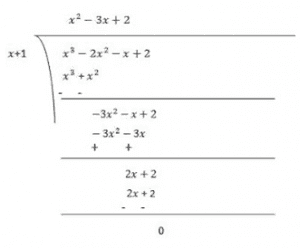 Now, Dividend = Divisor × Quotient + Remainder
(x+1)(x
2
–3x+2) = (x+1)(x
2
–x–2x+2)
= (x+1)(x(x−1)−2(x−1))
= (x+1)(x−1)(x-2)
Now, Dividend = Divisor × Quotient + Remainder
(x+1)(x
2
–3x+2) = (x+1)(x
2
–x–2x+2)
= (x+1)(x(x−1)−2(x−1))
= (x+1)(x−1)(x-2)
(ii) x 3 –3x 2 –9x–5
Solution: Let p(x) = x 3 –3x 2 –9x–5 Factors of 5 are ±1 and ±5 By the trial method, we find that p(5) = 0 So, (x-5) is factor of p(x) Now, p(x) = x 3 –3x 2 –9x–5 p(5) = (5) 3 –3(5) 2 –9(5)–5 = 125−75−45−5 = 0 Therefore, (x-5) is the factor of p(x)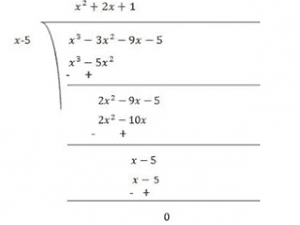 Now, Dividend = Divisor × Quotient + Remainder
(x−5)(x
2
+2x+1) = (x−5)(x
2
+x+x+1)
= (x−5)(x(x+1)+1(x+1))
= (x−5)(x+1)(x+1)
Now, Dividend = Divisor × Quotient + Remainder
(x−5)(x
2
+2x+1) = (x−5)(x
2
+x+x+1)
= (x−5)(x(x+1)+1(x+1))
= (x−5)(x+1)(x+1)
(iii) x 3 +13x 2 +32x+20
Solution: Let p(x) = x 3 +13x 2 +32x+20 Factors of 20 are ±1, ±2, ±4, ±5, ±10 and ±20 By the trial method, we find that p(-1) = 0 So, (x+1) is factor of p(x) Now, p(x)= x 3 +13x 2 +32x+20 p(-1) = (−1) 3 +13(−1) 2 +32(−1)+20 = −1+13−32+20 = 0 Therefore, (x+1) is the factor of p(x)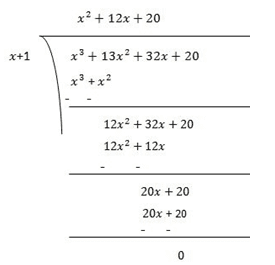 Now, Dividend = Divisor × Quotient +Remainder
(x+1)(x
2
+12x+20) = (x+1)(x
2
+2x+10x+20)
= (x+1)x(x+2)+10(x+2)
= (x+1)(x+2)(x+10)
Now, Dividend = Divisor × Quotient +Remainder
(x+1)(x
2
+12x+20) = (x+1)(x
2
+2x+10x+20)
= (x+1)x(x+2)+10(x+2)
= (x+1)(x+2)(x+10)
(iv) 2y 3 +y 2 –2y–1
Solution: Let p(y) = 2y 3 +y 2 –2y–1 Factors = 2×(−1)= -2 are ±1 and ±2 By the trial method, we find that p(1) = 0 So, (y-1) is factor of p(y) Now, p(y) = 2y 3 +y 2 –2y–1 p(1) = 2(1) 3 +(1) 2 –2(1)–1 = 2+1−2 = 0 Therefore, (y-1) is the factor of p(y)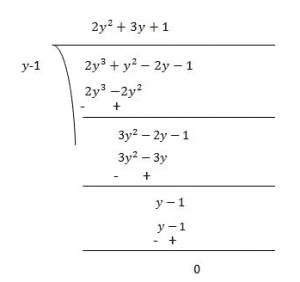 Now, Dividend = Divisor × Quotient + Remainder
(y−1)(2y
2
+3y+1) = (y−1)(2y
2
+2y+y+1)
= (y−1)(2y(y+1)+1(y+1))
= (y−1)(2y+1)(y+1)
Now, Dividend = Divisor × Quotient + Remainder
(y−1)(2y
2
+3y+1) = (y−1)(2y
2
+2y+y+1)
= (y−1)(2y(y+1)+1(y+1))
= (y−1)(2y+1)(y+1)
NCERT Solutions for Class 9 Maths Chapter 2 Exercise 2.5
Below we have provided NCERT Solutions for Class 9 Maths Chapter 2 Polynomials -1. Use suitable identities to find the following products:
(i) (x+4)(x +10)
Solution: Using the identity, (x+a)(x+b) = x 2 +(a+b)x+ab [Here, a = 4 and b = 10] We get, (x+4)(x+10) = x 2 +(4+10)x+(4×10) = x 2 +14x+40(ii) (x+8)(x –10)
Solution: Using the identity, (x+a)(x+b) = x 2 +(a+b)x+ab [Here, a = 8 and b = −10] We get, (x+8)(x−10) = x 2 +(8+(−10))x+(8×(−10)) = x 2 +(8−10)x–80 = x 2 −2x−80(iii) (3x+4)(3x–5)
Solution: Using the identity, (x+a)(x+b) = x 2 +(a+b)x+ab [Here, x = 3x, a = 4 and b = −5] We get, (3x+4)(3x−5) = (3x) 2 +[4+(−5)]3x+4×(−5) = 9x 2 +3x(4–5)–20 = 9x 2 –3x–20(iv) (y 2 +3/2)(y 2 -3/2)
Solution: Using the identity, (x+y)(x–y) = x 2 –y 2 [Here, x = y 2 and y = 3/2] We get, (y 2 +3/2)(y 2 –3/2) = (y 2 ) 2 –(3/2) 2 = y 4 –9/42. Evaluate the following products without multiplying directly:
(i) 103×107
Solution: 103×107= (100+3)×(100+7) Using identity, [(x+a)(x+b) = x 2 +(a+b)x+ab Here, x = 100 a = 3 b = 7 We get, 103×107 = (100+3)×(100+7) = (100) 2 +(3+7)100+(3×7) = 10000+1000+21 = 11021(ii) 95×96
Solution: 95×96 = (100-5)×(100-4) Using identity, [(x-a)(x-b) = x 2 -(a+b)x+ab Here, x = 100 a = -5 b = -4 We get, 95×96 = (100-5)×(100-4) = (100) 2 +100(-5+(-4))+(-5×-4) = 10000-900+20 = 9120(iii) 104×96
Solution: 104×96 = (100+4)×(100–4) Using identity, [(a+b)(a-b)= a 2 -b 2 ] Here, a = 100 b = 4 We get, 104×96 = (100+4)×(100–4) = (100) 2 –(4) 2 = 10000–16 = 99843. Factorise the following using appropriate identities:
(i) 9x 2 +6xy+y 2
Solution: 9x 2 +6xy+y 2 = (3x) 2 +(2×3x×y)+y 2 Using identity, x 2 +2xy+y 2 = (x+y) 2 Here, x = 3x y = y 9x 2 +6xy+y 2 = (3x) 2 +(2×3x×y)+y 2 = (3x+y) 2 = (3x+y)(3x+y)(ii) 4y 2 −4y+1
Solution: 4y 2 −4y+1 = (2y) 2 –(2×2y×1)+1 Using identity, x 2 – 2xy + y 2 = (x – y) 2 Here, x = 2y y = 1 4y 2 −4y+1 = (2y) 2 –(2×2y×1)+1 2 = (2y–1) 2 = (2y–1)(2y–1)(iii) x 2 –y 2 /100
Solution: x 2 –y 2 /100 = x 2 –(y/10) 2 Using identity, x 2 -y 2 = (x-y)(x+y) Here, x = x y = y/10 x 2 –y 2 /100 = x 2 –(y/10) 2 = (x–y/10)(x+y/10)4. Expand each of the following using suitable identities:
(i) (x+2y+4z) 2
(ii) (2x−y+z) 2
(iii) (−2x+3y+2z) 2
(iv) (3a –7b–c) 2
(v) (–2x+5y–3z) 2
(vi) ((1/4)a-(1/2)b +1) 2
Solution:(i) (x+2y+4z) 2
Using identity, (x+y+z) 2 = x 2 +y 2 +z 2 +2xy+2yz+2zx Here, x = x y = 2y z = 4z (x+2y+4z) 2 = x 2 +(2y) 2 +(4z) 2 +(2×x×2y)+(2×2y×4z)+(2×4z×x) = x 2 +4y 2 +16z 2 +4xy+16yz+8xz(ii) (2x−y+z) 2
Using identity, (x+y+z) 2 = x 2 +y 2 +z 2 +2xy+2yz+2zx Here, x = 2x y = −y z = z (2x−y+z) 2 = (2x) 2 +(−y) 2 +z 2 +(2×2x×−y)+(2×−y×z)+(2×z×2x) = 4x 2 +y 2 +z 2 –4xy–2yz+4xz(iii) (−2x+3y+2z) 2
Solution: Using identity, (x+y+z) 2 = x 2 +y 2 +z 2 +2xy+2yz+2zx Here, x = −2x y = 3y z = 2z (−2x+3y+2z) 2 = (−2x) 2 +(3y) 2 +(2z) 2 +(2×−2x×3y)+(2×3y×2z)+(2×2z×−2x) = 4x 2 +9y 2 +4z 2 –12xy+12yz–8xz(iv) (3a –7b–c) 2
Solution: Using identity (x+y+z) 2 = x 2 +y 2 +z 2 +2xy+2yz+2zx Here, x = 3a y = – 7b z = – c (3a –7b– c) 2 = (3a) 2 +(– 7b) 2 +(– c) 2 +(2×3a ×– 7b)+(2×– 7b ×– c)+(2×– c ×3a) = 9a 2 + 49b 2 + c 2 – 42ab+14bc–6ca(v) (–2x+5y–3z) 2
Solution: Using identity, (x+y+z) 2 = x 2 +y 2 +z 2 +2xy+2yz+2zx Here, x = –2x y = 5y z = – 3z (–2x+5y–3z) 2 = (–2x) 2 +(5y) 2 +(–3z) 2 +(2×–2x × 5y)+(2× 5y×– 3z)+(2×–3z ×–2x) = 4x 2 +25y 2 +9z 2 – 20xy–30yz+12zx(vi) ((1/4)a-(1/2)b+1) 2
Solution: Using identity, (x+y+z) 2 = x 2 +y 2 +z 2 +2xy+2yz+2zx Here, x = (1/4)a y = (-1/2)b z = 1
5. Factorise:
(i) 4x 2 +9y 2 +16z 2 +12xy–24yz–16xz
(ii) 2x 2 +y 2 +8z 2 –2√2xy+4√2yz–8xz
Solution:(i) 4x 2 +9y 2 +16z 2 +12xy–24yz–16xz
Using identity, (x+y+z) 2 = x 2 +y 2 +z 2 +2xy+2yz+2zx We can say that, x 2 +y 2 +z 2 +2xy+2yz+2zx = (x+y+z) 2 4x 2 +9y 2 +16z 2 +12xy–24yz–16xz = (2x) 2 +(3y) 2 +(−4z) 2 +(2×2x×3y)+(2×3y×−4z)+(2×−4z×2x) = (2x+3y–4z) 2 = (2x+3y–4z)(2x+3y–4z)(ii) 2x 2 +y 2 +8z 2 –2√2xy+4√2yz–8xz
Using identity, (x +y+z) 2 = x 2 +y 2 +z 2 +2xy+2yz+2zx We can say that, x 2 +y 2 +z 2 +2xy+2yz+2zx = (x+y+z) 2 2x 2 +y 2 +8z 2 –2√2xy+4√2yz–8xz = (-√2x) 2 +(y) 2 +(2√2z) 2 +(2×-√2x×y)+(2×y×2√2z)+(2×2√2×−√2x) = (−√2x+y+2√2z) 2 = (−√2x+y+2√2z)(−√2x+y+2√2z)6. Write the following cubes in expanded form:
(i) (2x+1) 3
(ii) (2a−3b) 3
(iii) ((3/2)x+1) 3
(iv) (x−(2/3)y) 3
Solution:(i) (2x+1) 3
Using identity,(x+y) 3 = x 3 +y 3 +3xy(x+y) (2x+1) 3 = (2x) 3 +1 3 +(3×2x×1)(2x+1) = 8x 3 +1+6x(2x+1) = 8x 3 +12x 2 +6x+1(ii) (2a−3b) 3
Using identity,(x–y) 3 = x 3 –y 3 –3xy(x–y) (2a−3b) 3 = (2a) 3 −(3b) 3 –(3×2a×3b)(2a–3b) = 8a 3 –27b 3 –18ab(2a–3b) = 8a 3 –27b 3 –36a 2 b+54ab 2(iii) ((3/2)x+1) 3
Using identity,(x+y) 3 = x 3 +y 3 +3xy(x+y) ((3/2)x+1) 3 =((3/2)x) 3 +1 3 +(3×(3/2)x×1)((3/2)x +1)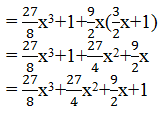
(iv) (x−(2/3)y) 3
Using identity, (x –y) 3 = x 3 –y 3 –3xy(x–y)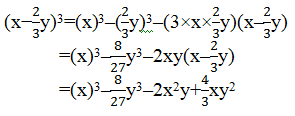
7. Evaluate the following using suitable identities:
(i) (99) 3
(ii) (102) 3
(iii) (998) 3
Solutions:(i) (99) 3
Solution: We can write 99 as 100–1 Using identity, (x –y) 3 = x 3 –y 3 –3xy(x–y) (99) 3 = (100–1) 3 = (100) 3 –1 3 –(3×100×1)(100–1) = 1000000 –1–300(100 – 1) = 1000000–1–30000+300 = 970299(ii) (102) 3
Solution: We can write 102 as 100+2 Using identity,(x+y) 3 = x 3 +y 3 +3xy(x+y) (100+2) 3 =(100) 3 +2 3 +(3×100×2)(100+2) = 1000000 + 8 + 600(100 + 2) = 1000000 + 8 + 60000 + 1200 = 1061208(iii) (998) 3
Solution: We can write 99 as 1000–2 Using identity,(x–y) 3 = x 3 –y 3 –3xy(x–y) (998) 3 =(1000–2) 3 =(1000) 3 –2 3 –(3×1000×2)(1000–2) = 1000000000–8–6000(1000– 2) = 1000000000–8- 6000000+12000 = 9940119928. Factorise each of the following:
(i) 8a 3 +b 3 +12a 2 b+6ab 2
(ii) 8a 3 –b 3 –12a 2 b+6ab 2
(iii) 27–125a 3 –135a +225a 2
(iv) 64a 3 –27b 3 –144a 2 b+108ab 2
(v) 27p 3 –(1/216)−(9/2) p 2 +(1/4)p
Solutions:(i) 8a 3 +b 3 +12a 2 b+6ab 2
Solution: The expression, 8a 3 +b 3 +12a 2 b+6ab 2 can be written as (2a) 3 +b 3 +3(2a) 2 b+3(2a)(b) 2 8a 3 +b 3 +12a 2 b+6ab 2 = (2a) 3 +b 3 +3(2a) 2 b+3(2a)(b) 2 = (2a+b) 3 = (2a+b)(2a+b)(2a+b) Here, the identity, (x +y) 3 = x 3 +y 3 +3xy(x+y) is used.(ii) 8a 3 –b 3 –12a 2 b+6ab 2
Solution: The expression, 8a 3 –b 3 −12a 2 b+6ab 2 can be written as (2a) 3 –b 3 –3(2a) 2 b+3(2a)(b) 2 8a 3 –b 3 −12a 2 b+6ab 2 = (2a) 3 –b 3 –3(2a) 2 b+3(2a)(b) 2 = (2a–b) 3 = (2a–b)(2a–b)(2a–b) Here, the identity,(x–y) 3 = x 3 –y 3 –3xy(x–y) is used.(iii) 27–125a 3 –135a+225a 2
Solution: The expression, 27–125a 3 –135a +225a 2 can be written as 3 3 –(5a) 3 –3(3) 2 (5a)+3(3)(5a) 2 27–125a 3 –135a+225a 2 = 3 3 –(5a) 3 –3(3) 2 (5a)+3(3)(5a) 2 = (3–5a) 3 = (3–5a)(3–5a)(3–5a) Here, the identity, (x–y) 3 = x 3 –y 3 -3xy(x–y) is used.(iv) 64a 3 –27b 3 –144a 2 b+108ab 2
Solution: The expression, 64a 3 –27b 3 –144a 2 b+108ab 2 can be written as (4a) 3 –(3b) 3 –3(4a) 2 (3b)+3(4a)(3b) 2 64a 3 –27b 3 –144a 2 b+108ab 2 = (4a) 3 –(3b) 3 –3(4a) 2 (3b)+3(4a)(3b) 2 =(4a–3b) 3 =(4a–3b)(4a–3b)(4a–3b) Here, the identity, (x – y) 3 = x 3 – y 3 – 3xy(x – y) is used.(v) 27p 3 – (1/216)−(9/2) p 2 +(1/4)p
Solution: The expression, 27p 3 –(1/216)−(9/2) p 2 +(1/4)p can be written as (3p) 3 –(1/6) 3 −(9/2) p 2 +(1/4)p = (3p) 3 –(1/6) 3 −3(3p)(1/6)(3p – 1/6) Using (x – y) 3 = x 3 – y 3 – 3xy (x – y) 27p 3 –(1/216)−(9/2) p 2 +(1/4)p = (3p) 3 –(1/6) 3 −3(3p)(1/6)(3p – 1/6) Taking x = 3p and y = 1/6 = (3p–1/6) 3 = (3p–1/6)(3p–1/6)(3p–1/6)9. Verify:
(i) x 3 +y 3 = (x+y)(x 2 –xy+y 2 )
(ii) x 3 –y 3 = (x–y)(x 2 +xy+y 2 )
Solutions:(i) x 3 +y 3 = (x+y)(x 2 –xy+y 2 )
We know that, (x+y) 3 = x 3 +y 3 +3xy(x+y) ⇒ x 3 +y 3 = (x+y) 3 –3xy(x+y) ⇒ x 3 +y 3 = (x+y)[(x+y) 2 –3xy] Taking (x+y) common ⇒ x 3 +y 3 = (x+y)[(x 2 +y 2 +2xy)–3xy] ⇒ x 3 +y 3 = (x+y)(x 2 +y 2 –xy)(ii) x 3 –y 3 = (x–y)(x 2 +xy+y 2 )
We know that, (x–y) 3 = x 3 –y 3 –3xy(x–y) ⇒ x 3 −y 3 = (x–y) 3 +3xy(x–y) ⇒ x 3 −y 3 = (x–y)[(x–y) 2 +3xy] Taking (x+y) common ⇒ x 3 −y 3 = (x–y)[(x 2 +y 2 –2xy)+3xy] ⇒ x 3 +y 3 = (x–y)(x 2 +y 2 +xy)10. Factorise each of the following:
(i) 27y 3 +125z 3
(ii) 64m 3 –343n 3
Solutions:(i) 27y 3 +125z 3
The expression, 27y 3 +125z 3 can be written as (3y) 3 +(5z) 3 27y 3 +125z 3 = (3y) 3 +(5z) 3 We know that, x 3 +y 3 = (x+y)(x 2 –xy+y 2 ) 27y 3 +125z 3 = (3y) 3 +(5z) 3 = (3y+5z)[(3y) 2 –(3y)(5z)+(5z) 2 ] = (3y+5z)(9y 2 –15yz+25z 2 )(ii) 64m 3 –343n 3
The expression, 64m 3 –343n 3 can be written as (4m) 3 –(7n) 3 64m 3 –343n 3 = (4m) 3 –(7n) 3 We know that, x 3 –y 3 = (x–y)(x 2 +xy+y 2 ) 64m 3 –343n 3 = (4m) 3 –(7n) 3 = (4m-7n)[(4m) 2 +(4m)(7n)+(7n) 2 ] = (4m-7n)(16m 2 +28mn+49n 2 )11. Factorise: 27x 3 +y 3 +z 3 –9xyz.
Solution: The expression 27x 3 +y 3 +z 3 –9xyz can be written as (3x) 3 +y 3 +z 3 –3(3x)(y)(z) 27x 3 +y 3 +z 3 –9xyz = (3x) 3 +y 3 +z 3 –3(3x)(y)(z) We know that, x 3 +y 3 +z 3 –3xyz = (x+y+z)(x 2 +y 2 +z 2 –xy –yz–zx) 27x 3 +y 3 +z 3 –9xyz = (3x) 3 +y 3 +z 3 –3(3x)(y)(z) = (3x+y+z)[(3x) 2 +y 2 +z 2 –3xy–yz–3xz] = (3x+y+z)(9x 2 +y 2 +z 2 –3xy–yz–3xz)12. Verify that:
x 3 +y 3 +z 3 –3xyz = (1/2) (x+y+z)[(x–y) 2 +(y–z) 2 +(z–x) 2 ]
Solution: We know that, x 3 +y 3 +z 3 −3xyz = (x+y+z)(x 2 +y 2 +z 2 –xy–yz–xz) ⇒ x 3 +y 3 +z 3 –3xyz = (1/2)(x+y+z)[2(x 2 +y 2 +z 2 –xy–yz–xz)] = (1/2)(x+y+z)(2x 2 +2y 2 +2z 2 –2xy–2yz–2xz) = (1/2)(x+y+z)[(x 2 +y 2 −2xy)+(y 2 +z 2 –2yz)+(x 2 +z 2 –2xz)] = (1/2)(x+y+z)[(x–y) 2 +(y–z) 2 +(z–x) 2 ]13. If x+y+z = 0, show that x 3 +y 3 +z 3 = 3xyz.
Solution: We know that, x 3 +y 3 +z 3 -3xyz = (x +y+z)(x 2 +y 2 +z 2 –xy–yz–xz) Now, according to the question, let (x+y+z) = 0, Then, x 3 +y 3 +z 3 -3xyz = (0)(x 2 +y 2 +z 2 –xy–yz–xz) ⇒ x 3 +y 3 +z 3 –3xyz = 0 ⇒ x 3 +y 3 +z 3 = 3xyz Hence Proved14. Without actually calculating the cubes, find the value of each of the following:
(i) (−12) 3 +(7) 3 +(5) 3
(ii) (28) 3 +(−15) 3 +(−13) 3
Solution:(i) (−12) 3 +(7) 3 +(5) 3
Let a = −12 b = 7 c = 5 We know that if x+y+z = 0, then x 3 +y 3 +z 3 =3xyz. Here, −12+7+5=0 (−12) 3 +(7) 3 +(5) 3 = 3xyz = 3×-12×7×5 = -1260(ii) (28) 3 +(−15) 3 +(−13) 3
Solution: (28) 3 +(−15) 3 +(−13) 3 Let a = 28 b = −15 c = −13 We know that if x+y+z = 0, then x 3 +y 3 +z 3 = 3xyz. Here, x+y+z = 28–15–13 = 0 (28) 3 +(−15) 3 +(−13) 3 = 3xyz = 0+3(28)(−15)(−13) = 1638015. Give possible expressions for the length and breadth of each of the following rectangles, in which their areas are given:
(i) Area: 25a 2 –35a+12
(ii) Area: 35y 2 +13y–12
Solution: (i) Area: 25a 2 –35a+12 Using the splitting the middle term method, We have to find a number whose sum = -35 and product =25×12 = 300 We get -15 and -20 as the numbers [-15+-20=-35 and -15×-20 = 300] 25a 2 –35a+12 = 25a 2 –15a−20a+12 = 5a(5a–3)–4(5a–3) = (5a–4)(5a–3) Possible expression for length = 5a–4 Possible expression for breadth = 5a –3 (ii) Area: 35y 2 +13y–12 Using the splitting the middle term method, We have to find a number whose sum = 13 and product = 35×-12 = 420 We get -15 and 28 as the numbers [-15+28 = 13 and -15×28=420] 35y 2 +13y–12 = 35y 2 –15y+28y–12 = 5y(7y–3)+4(7y–3) = (5y+4)(7y–3) Possible expression for length = (5y+4) Possible expression for breadth = (7y–3)16. What are the possible expressions for the dimensions of the cuboids whose volumes are given below?
(i) Volume: 3x 2 –12x
(ii) Volume: 12ky 2 +8ky–20k
Solution: (i) Volume: 3x 2 –12x 3x 2 –12x can be written as 3x(x–4) by taking 3x out of both the terms. Possible expression for length = 3 Possible expression for breadth = x Possible expression for height = (x–4) (ii) Volume: 12ky 2 +8ky–20k 12ky 2 +8ky–20k can be written as 4k(3y 2 +2y–5) by taking 4k out of both the terms. 12ky 2 +8ky–20k = 4k(3y 2 +2y–5) [Here, 3y 2 +2y–5 can be written as 3y 2 +5y–3y–5 using splitting the middle term method.] = 4k(3y 2 +5y–3y–5) = 4k[y(3y+5)–1(3y+5)] = 4k(3y+5)(y–1) Possible expression for length = 4k Possible expression for breadth = (3y +5) Possible expression for height = (y -1)Benefits of NCERT Solutions for Class 9 Maths Chapter 2
NCERT Solutions for Class 9 Maths Chapter 2, "Polynomials," offer several benefits for students:Clear Understanding : They provide step-by-step solutions to exercises in the textbook, helping students grasp complex concepts and solve polynomial problems more easily.
Concept Reinforcement : By offering detailed explanations and varied examples, these solutions reinforce the fundamental principles of polynomials, ensuring a strong conceptual foundation.
Practice and Mastery : Students can practice different types of polynomial problems, which helps in mastering the topic and gaining confidence in solving similar questions during exams.
Homework Assistance : The NCERT Solutions for Class 9 Maths Chapter 2 serve as a useful tool for completing homework assignments accurately and efficiently, reducing confusion and errors.
Exam Preparation : They are valuable for revising key concepts and practicing problem-solving techniques, which is crucial for scoring well in exams.
NCERT Solutions for Class 9 Maths Chapter 2 FAQs












